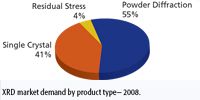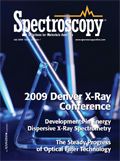Market Profile: X-Ray Diffractometry
X-ray diffractometry (XRD) is an X-ray–based method for determining the crystal structure of a material. Because X-ray wavelengths are of roughly the same size as the interatomic spacings of a crystal, significant diffraction of the waves occurs.
X-ray diffractometry (XRD) is an X-ray–based method for determining the crystal structure of a material. Because X-ray wavelengths are of roughly the same size as the interatomic spacings of a crystal, significant diffraction of the waves occurs. Because of the regularities inherent in a crystal structure, monochromatic X-rays are diffracted at various angles with different intensities. For a single crystal of a material, the result is a pattern of bright von Laue spots on the detector. This pattern can be inverted mathematically to determine the crystal structure of the sample, providing information on the chemical structure of the sample. Alternatively, the diffractogram can be compared to a known library in order to identify the sample.

XRD market demand by product type- 2008.
Three main types of sample commonly are analyzed by XRD. Large, single crystals provide the clearest diffraction patterns and XRD can help to solve the atomic structures of complex proteins, although preparing a pure crystal can be problematic. Instead of single crystals, powders consisting of many small crystals with random orientations can be analyzed. This smears out the von Laue spots, but the diffractograms generally are suitable for identification purposes. Finally, metal samples can be analyzed by XRD, which can reveal residual stress in the metal where the atomic spacings have been deformed, indicating potential weakness in the material.
Newer techniques that are variations on XRD are also being explored. Energy dispersive XRD (EDXRD) uses a non-monochromatic X-ray source, but otherwise uses a similar method for sample identification. Systems that provide combined XRD and X-ray fluorescence (XRF) analysis have also found their way to the marketplace recently. XRF provides complementary information about the sample's elemental composition. Combined XRD/XRF has applications in geology and mineralogy.
Some of the foregoing data were extracted from SDi's market analysis and perspectives report entitled Global Assessment Report, 10th Edition: The Laboratory Life Science and Analytical Instrument Industry, September 2008. For more information, contact Michael Tice, VP of Consulting Services, Strategic Directions International, Inc., 6242 Westchester Parkway Suite 100, Los Angeles, CA 90045, (310) 641-4982, fax: (310) 641-8851, www.strategic-directions.com.

AI Shakes Up Spectroscopy as New Tools Reveal the Secret Life of Molecules
April 14th 2025A leading-edge review led by researchers at Oak Ridge National Laboratory and MIT explores how artificial intelligence is revolutionizing the study of molecular vibrations and phonon dynamics. From infrared and Raman spectroscopy to neutron and X-ray scattering, AI is transforming how scientists interpret vibrational spectra and predict material behaviors.
Advancing Corrosion Resistance in Additively Manufactured Titanium Alloys Through Heat Treatment
April 7th 2025Researchers have demonstrated that heat treatment significantly enhances the corrosion resistance of additively manufactured TC4 titanium alloy by transforming its microstructure, offering valuable insights for aerospace applications.